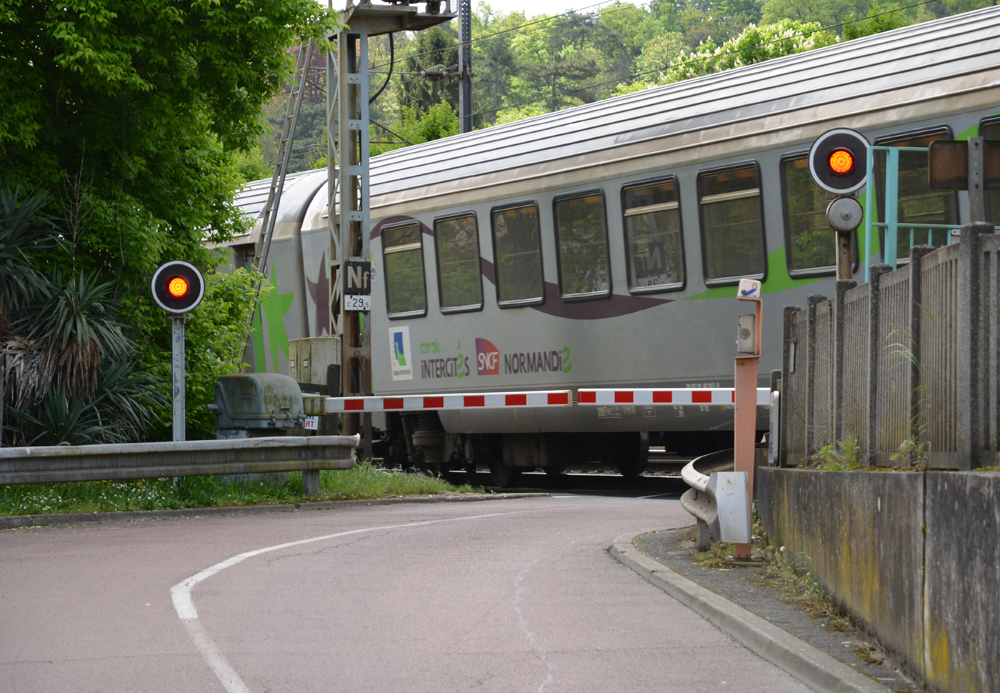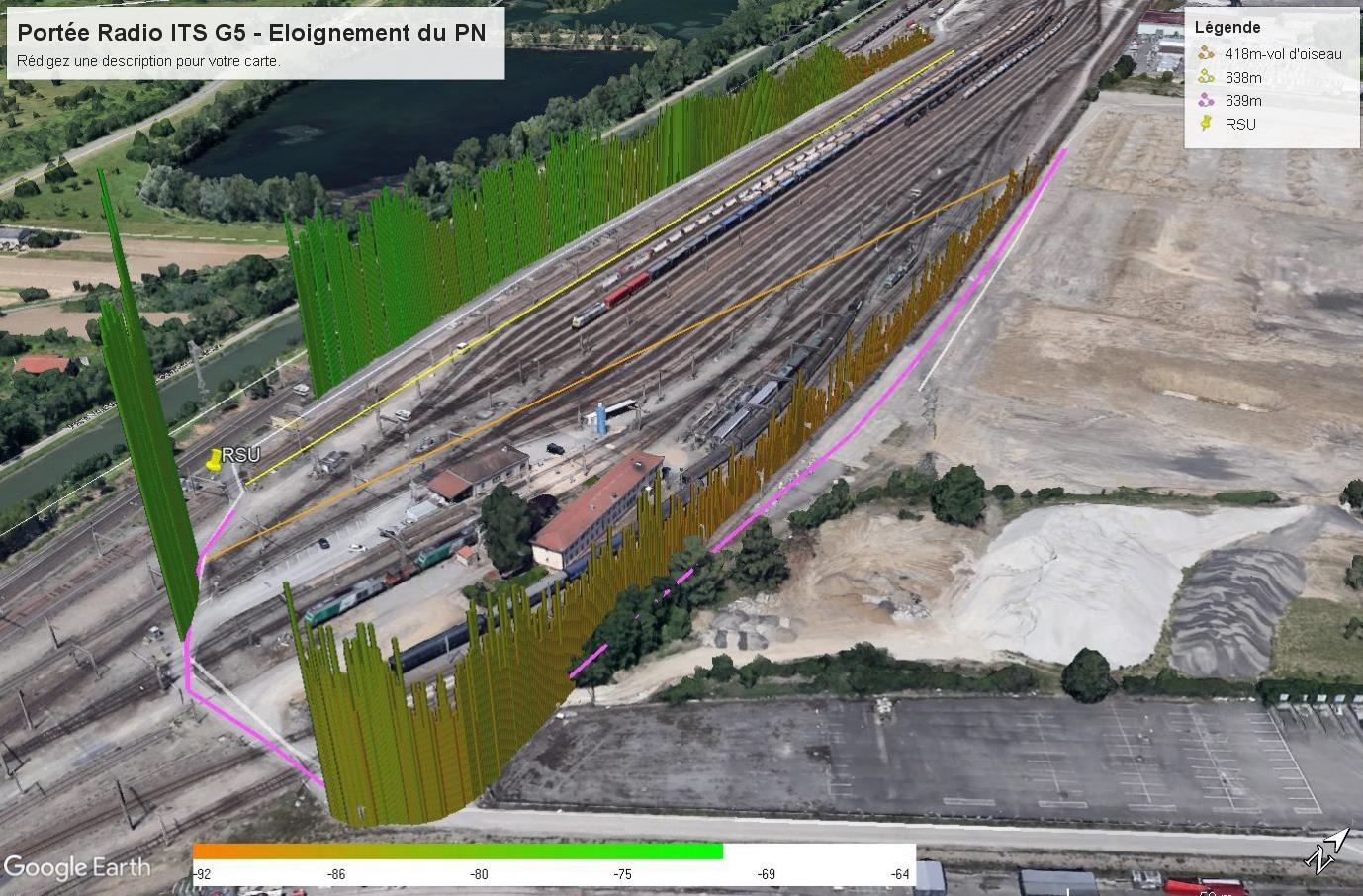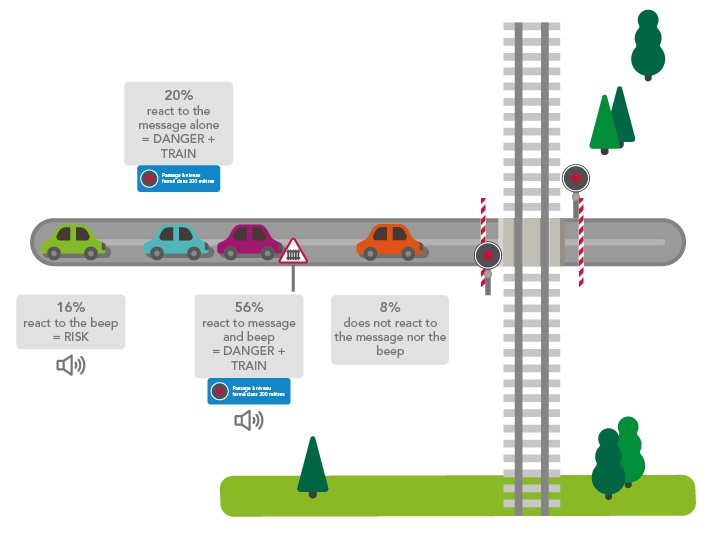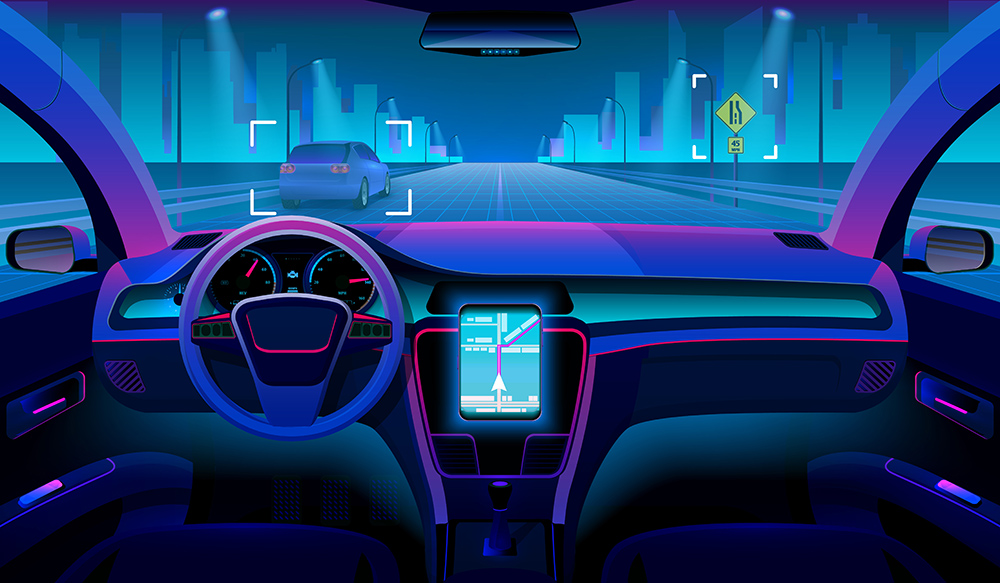
In France, the infrastructure managed by national railway operator SNCF includes more than 15,400 level crossings where road meets rail. While accidents at level crossings represent less than 1% of the total number of road deaths – they account for more than 37% of fatalities that involve railways (excluding suicide).
Over the last 10 years, the number of collisions between cars and trains at level crossings has hovered between 100 and 140 each year – causing between 25 and 40 fatalities.
Around 99% of accidents are due to non-compliance with the rules of the road, whether voluntary (trying to get across the track before a train arrives) or involuntary (some kind of driver impairment).
There are three main causes of accidents:
- Level crossing violation
- Driving error
- Distraction
Cooperative ITS (C-ITS) may be a way to mitigate the problem. Different C-ITS projects are emerging in France and throughout Europe as a new means of solving various issues related to road safety, including optimisation of road traffic in cities and pollution reduction.
Smart crossings
The SNCF’s Innovation and Research Department believes this field of technological development provides new solutions for the safety of level crossings, transforming them into ‘smart’ crossings by communication with connected vehicles. This could reduce the number of collisions generated by inappropriate behaviour and distraction, the French company believes.

SNCF’s Innovation and Research Department developed different Infrastructure to Vehicle (I2V) use cases which mean:
The level crossing sends information about its status to the vehicle – e.g. whether it is open, closed, or if there is a technical problem such as a broken barrier, or if there is work ongoing on the crossing and the road is closed.
The crossing sends its characteristics in terms of restrictions in width, height, weight, ground, speed and, in the event of a problem, sends a message telling the driver to use the phone which is installed at each automatic level crossing.
But it works two ways, with Vehicle to Infrastructure (V2I) communication allowing the vehicle to send information to the smart level crossing in case of distress – such as breakdown on the track, with its location.
The important thing is that it is possible to improve crossing safety without making major infrastructure changes or altering the way the crossing itself works.
A control module monitors the state of the electrical relays, with a set of algorithms giving the precise status of the level crossing in real time. A transmission module connected to the control module makes it possible for the crossing to communicate with third parties.
A prototype of the transmission system (or roadside unit) was designed in 2018 to be modular in terms of telecom technologies, but also to be able to interface with any existing or future remote monitoring system.
In order to communicate with any type of connected vehicle, the system is designed to send messages both in ITSG5 and LTE.
Encouraging results
In parallel, SNCF signed a partnership with Valeo to test the system. SNCF equipped an automatic light system (ALS) level crossing with G5 and GPS antennas, plus control and transmission modules.
The crossing broadcasts a status message (closed, open, out of order or work in progress) as well as its location in G5 to the vehicle. The vehicle displays different messages according to its localisation and speed to give the driver on the road the best possible information on which to base decisions.
SNCF obtained encouraging results for its first demonstration, with more than 650m of range on straight roads and 250m on curved roads and with obstacles (building and trains parked), and less than 300 milliseconds of latency.
In 2019 SNCF became part of the C-Roads France project as an associate partner. C-Roads France is a contribution from France to the European C-Roads Platform which synthesises feedback from national projects and foreshadows technical and functional developments and directions for future systems deployed across the continent. These projects are part of a coherent approach which also incorporates Directive 2010/40 and the Delegated Act.

SNCF integrated the European C-Roads architecture with hybrid communication, which means in addition to sending messages in ITS G5 to the vehicle, the level crossing also sends messages in 4G through the national ITS station.
The tests, carried out in September 2019, enabled SNCF to validate the following:
- Different uses cases with status (as in 2018) and characteristics of the level crossing (new messages if the crossing has restrictions of height, speed, width, weight or specific ground)
- Different types of G5 antennas with different configurations and their range for each
- Detection of vehicle in distress in the level crossing area, allowing the crossing to send an alarm to the train or operator
The tests were realised on an ALS level crossing in Brittany, with the following results:
- In ITS G5, as the configuration of the road was more difficult with sharp curves and tree density, the range was only 280m on one side and 70m on the other, with less than 300 milliseconds of latency
- In 4G, depending on the quality of the network, SNCF could obtain up to 1km of range
New developments were made in 2020 to integrate, in the prototype, the cybersecurity layer of the ETSI standard and the European requirements of Directive 2010/40/EU and the Delegated Act of 3/13/2019 in order to achieve cross-border harmonisation and interoperability.
Unit tests were successfully carried out in July and August to validate the design of the messages, the integration of cybersecurity and the management of certificates on the mock-up showing a level crossing in 1/87 format.
Subsequently, full chain tests were carried out on the 449 level crossing at Brec’h and enabled the validation of the device in September 2020 with the supplier, Neo GLS.
Driver impact
To measure the impact on road driver behaviour, SNCF launched with ECF a study of 25 car driver participants.
Each took a 20-30 minute course in a driving simulator with three ‘reference’ situations and six different connected vehicle scenarios, after which they had a 30-50 minute interview.
This comprised questions of knowledge, behaviour and situations in the simulator around four elements: what they saw, what they thought when they saw, what they did and what they understood.
During this simulator test, SNCF found that unequivocal messages (such as ‘level crossing closed’) allowed subjects to have a clear indication of the status of the level crossing. They then slow their speed early. In this case, the rate of subjects with an anticipation profile is 92% (a third more than for the ‘reference’ situation).
However, when drivers are in doubt, in particular over the status of the level crossing (such as with the message ‘level crossing at 200m’), messages required an effort of reflection by the subject – and this had variable results in relation to their ability to anticipate subjects.

These kind of messages are then less effective, even if they avoid the distraction phenomenon and are complementary to the automatic level crossing sign.
A few subjects (8%) of all ages were resistant to driving-assistance devices - and especially to screens (GPS, smartphone apps and so on) – and therefore did not react to the messages they receive.
Mobility is now a must for any infrastructure manager. SNCF says its projects on level crossings, at the intersection of road and rail flows, show the company’s desire to create sustainable and safe mobility offers for all users.
“The construction of an interface between road and rail at the service of people is therefore an example of SNCF’s involvement in safer mobility for all users,” it adds. “ITS through the display of messages in the passenger compartment of the connected vehicle or through a smartphone application can provide additional security levers at level crossings. Communication to connected vehicles is a first step and new work with autonomous vehicles is opening up.”
All the level crossing tests carried out between 2018 and 2020 enabled the prototype to be validated in accordance with the requirements of European directives and standards. On the strength of its feedback, SNCF submitted the use cases for level crossings to standards organisation ETSI in order to achieve standardisation at European level.












